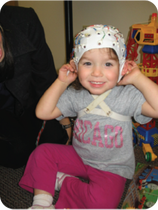Research Projects in Typical Development
Our research in typical development encompasses the areas of concept formation and quantitative reasoning. We study these topics in infants as well as children from about 4 to 15 years of age.
Visual Processing and Cognitive Development in Infants and Toddlers
We investigate the role that visual attention plays inter-connectedly between perception, developing cognition and behavior in early infancy. Specifically, we are interested in how infants perceive and learn about objects in the world, and how selective attention is involved in this area of cognitive development. Object-based selective attention is thought to be an essential component of statistical learning mechanisms – processes that drive our ability to recognize regularities and patterns in our environment - and to learn from the changes in the dynamic world around us. Additionally, object-based selective attention and “the object concept” are considered integral building blocks for higher-level thinking such as categorizing and counting.
We use eye-tracking data to assess the way infants look at different object displays; actually tracking their attention as it moves around the screen. We then compare the visual behavior of the group of infants with fragile X to the group with no disorder. This provides us with a measure of how attention is working differently in the brains of infants with fragile X, as compared to how attention functions in “typically”-developing infant brains.
* This study is currently recruiting. If you are interested in participating, please contact us here.
Faces and Emotion Study
Visual attention and emotion processing have implications for social-emotional and cognitive wellbeing. While some level of attention is necessary for adaptive functioning, excessive attention to threat (i.e. threat bias) in the environment has been linked to the development and maintenance of anxiety disorders. This study investigates the link between early visual processing biases, related neural activation, and symptoms of anxiety and emotion dysregulation in later development. We use a combination of neuroscientific methods to examine brain activity via EEG/ERP, and behavioral methods including infrared eye-tracking and neuropsychological assessments to examine the brain-behavior relationship in social-cognitive development.
Participants are typically-developing children, ranging from infancy to school-age. During the first session, children passively view images of faces varying in emotional expression and other emotionally-evoking images while brain activity is recorded via EEG/ERP. During the second session, children complete and eye-tracking task which includes viewing images of facial expressions on a computer screen while we record the reflection of light in the eye to measure where the eye is looking.
* This study is currently recruiting. If you are interested in participating, please contact us here.

